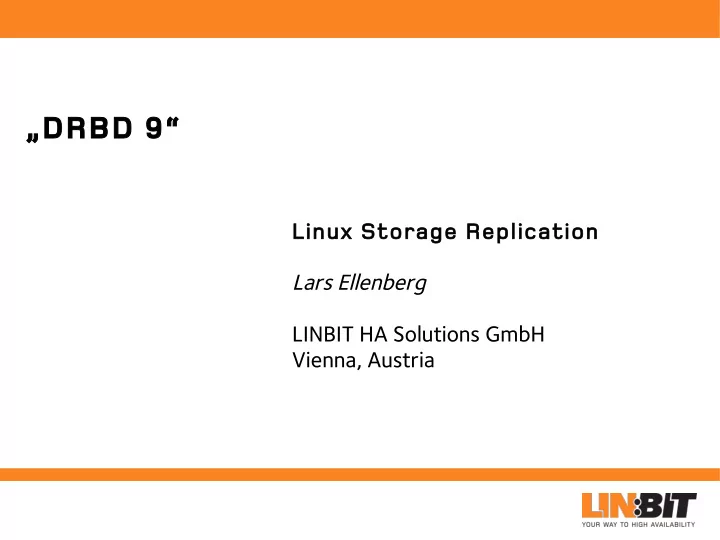

„DRBD 9“ Linux Storage Replication Lars Ellenberg LINBIT HA Solutions GmbH Vienna, Austria
What this talk is about What is replication • Why block level replication • Why replication • What do we have to deal with • How we are dealing with it now • Where development is headed •
Linux Storage Replication Replication Basics DRBD 8 Overview DM-Replicator DRBD 9 Other Ideas
Linux Storage Replication Replication Basics DRBD 8 Overview DM-Replicator DRBD 9 Other Ideas
Standalone Servers No System Level Redundancy • Vulnerable to Failures Important Systems • Node 1 Node 2 Node 3
Application Level Replication Special Purpose Solution • Difficult to add to an application Important Systems • after the fact App App Node 1 Node 3
Filesystem Level Replication Special Filesystem • Complex Important Systems • Replicate on dirty? • Node 1 Node 3 FS FS ... on writeout? • ... on close? • What about metadata? • Resilience? •
Shared Storage (SAN) No Storage Redundancy • Important Systems Node 1 Node 2 Node 3 FC, iSCSI Shared data Shared Storage/SAN
Replication capable SAN Application agnostic • Expensive Hardware Important Systems • Expensive License costs • Node 1 Node 2 Node 3 FC, iSCSI Shared data Replica Shared Storage/SAN Shared Storage/SAN
Block Level Replication Storage Redundancy • Application Agnostic • DRBD Node 1 Node 2 Generic • Cluster Flexible •
SAN Replacement Storage Cluster Storage Redundancy • Application Agnostic Important Systems • Generic • Node 1 Node 2 Node 3 Flexible • iSCSI DRBD Node 1 Node 2 Storage Cluster
Linux Storage Replication Replication Basics DRBD 8 Overview DM-Replicator DRBD 9 Other Ideas
How it works: Normal operation Write I/O Write I/O Application Read I/O Read I/O Primary Node Data blocks Replicate Replicate Acknowledge Acknowledge Secondary Node Data blocks
How it works: Primary Node Failure Write I/O Application Read I/O Read I/O Write I/O Primary Node Read I/O Read I/O Data blocks Application Replicate Acknowledge Secondary Node Primary Node Data blocks
How it works: Secondary Node Failure Write I/O Write I/O Application Read I/O Read I/O Primary Node Data blocks Offline Node Data blocks
How it works: Secondary Node Recovery Application Read I/O Read I/O Primary Node Data blocks Resync Resync Acknowledge Acknowledge Secondary Node Data blocks
What if ... We want additional replica for desaster recovery • - we can stack DRBD The latency to the remote site is too high • - stack DRBD for local redundancy, run the high latency link in asynchronous mode, add buffering and compressing with DRBD proxy Primary node/site fails during resync • - Snapshot before becoming sync target
It Works. Though it may be ugly. • Can we do better? •
Linux Storage Replication Replication Basics DRBD 8 Overview DM-Replicator DRBD 9 Other Ideas
Generic Replication Framework Track Data changes • - Persistent (on Disk) Data Journal - “global” write ordering over multiple volumes - Fallback to bitmap based change tracking Multi-node. • - many “site links” feed from the journal Flexible Policy • - When to report completion to upper layers - (when to) do fallback to bitmap
Current „default“ reference implementation Only talks to “dumb” block devices • “Software RAID1” • allowing some legs to lag behind No concept of “data generation” • Cannot communicate metadata • Not directly suitable for failover solutions • Primary objective: cut down on “hardware” replication licence • costs, replicate SAN-LUNs in software to desaster recovery sites.
DRBD 9 Replication Basics DRBD 8 Overview DM-Replicator DRBD 9 Other Ideas
Replicating smarter, asynchronous Detect and discard overwrites • - shipped batches must be atomic Compress • Compress XOR-diff • Side effects • - Can be undone - Checkpointing of generic block data - Point in time recovery
Replicating smarter, synchronous Identify a certain Data Set Version • Start from scratch • continuous stream of changes • Data Generation Tags, dagtag • - which clone (node name) - which volume (label) - who modified it last (committer) - modification date (position in the change stream)
Colorful Replication Stream Data Set Divergence Primary Node Changes atomic batch discarding overwrites
Advantages of the Data Generation Tag scheme On handshake, exchange dagtag s • - Trivially see who has the best data even on primary site failure with multiple secondaries possibly lagging behind Communicate dagtags with atomic (compressed, xor-diff) • batches - allows for daisy chaining keep dagtag and batch payload • - Checkpointing: just store the dagtag .
DRBD 9 Replication Basics DRBD 8 Overview DM-Replicator DRBD 9 Other Ideas
Stretched cluster file systems? Multiple branch offices • One cluster filesystem • Latency would make unusable • But when • - keeping leases and - inserting lock requests into the replication data stream - while having mostly self-contained access in the branch offices It may feel like low latency most of the time, with occasional • longer delays on access. Tell me why I'm wrong :-) •
Comments? lars@linbit.com http://www.linbit.com http://www.drbd.org If you think you can help, we are Hireing!
Recommend
More recommend